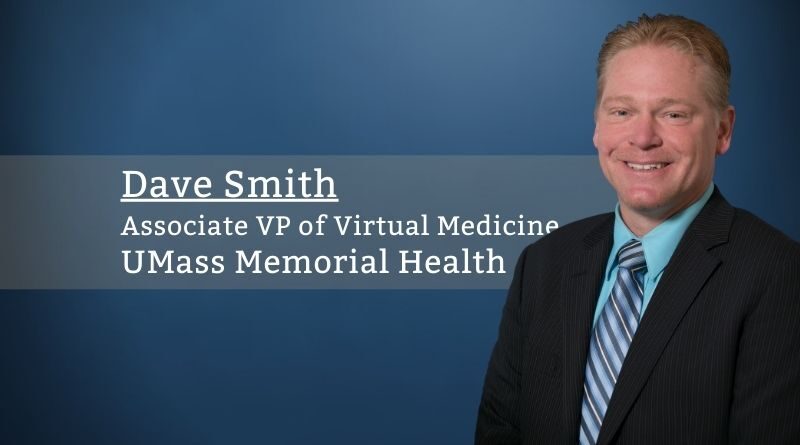Ten Takeaways on Telehealth from the Perspective of a Pandemic
By Dave Smith, Associate VP of Virtual Medicine, UMass Memorial Health
Few, if any, of our cohorts in healthcare IT could have foreseen the unveiling of a global outbreak in the early days of 2020. And while my health system had dabbled in telemedicine for well over a decade, we were woefully unprepared, as were many, when the first wave slapped our doors shut. By the second month into the public health emergency, our volume had increased by 2000% over pre-COVID days. We had moved the needle by years in a matter of months, even weeks.
Telehealth proved its value during the pandemic out of necessity. And now, we must not let it lose its luster.
The pandemic offered little hope to humanity, save one thing. The hope of innovation, out of necessity and desperation, in the form of a digital paradigm shift in healthcare. Seemingly overnight, all of the fears and skepticism of this emerging care model were swept away, and telehealth was embraced by the masses. Out of the most challenging and heartbreaking year for many of us, our families, friends, and colleagues, I offer these perspectives on what it taught us.
- The policy was not in line with the times. Prior to the PHE, CMS limited telehealth access to only rural areas – and only at facilities designated under the antiquated provisions of the Social Security Act. Fortunately, Congress acted quickly to temporarily waive the geographic restrictions on telehealth and allow social communication technologies, such as FaceTime, to be used without repercussion. It is yet to be determined whether these waivers will remain in effect long term.
Despite the uncertainty… - Telehealth became the safer, and sometimes, the only choice. Almost immediately, all routine visits and elective surgeries were canceled to accommodate the surge of COVID cases flooding our EDs and ICUs. Personal protective equipment was at a premium as we struggled to understand the epidemiology of this disease. “Tele-” (aka “distant-”) health provided a natural barrier between the virus and our caregivers, and it allowed our patients to be seen without in-person contact. In just two short months, we had completed over 80,000 such visits.
Nonetheless… - Adoption was a choice. Even with the high demand for virtual care during the pandemic, there was no guarantee that telehealth would be leveraged to its full potential for various reasons. Lack of familiarity, technology hurdles and frustration, the perception (or reality) of creating more work for the caregiver, etc. Human nature will almost always gravitate toward the easier or more comfortable path if the change is not purposeful.
And so, we learned… - It must be simple to use and readily available. The core tenets that “everyone knows how to use Zoom” and “everyone has a smartphone” turned out to be fundamentally flawed. In fact, nearly 1 in 3 of our patients were deterred by the so-called “every day” technologies that most of us in healthcare IT take for granted.
This created its own challenge… - Keeping patients in touch with family was critical. One unintended consequence of restricting all visitation was the isolation that bore down on our patients. Solving this became a crucial use case for telehealth. Staff was using their own social media accounts and personal devices to make sure that patients could see their loved ones – sometimes for the last time. We now have purpose-built tools for patient-family communication and even a virtual companionship program for those who just need someone to talk to. Which supports the notion…
- Telehealth aligns with consumer expectations. Perhaps for the first time in modern medicine, our patients want to choose when and how they receive healthcare services. They want convenience, access, value, and an overall positive experience. As such, telehealth aligns with consumerism in the same way that Amazon appeals to online shoppers. Why wait weeks to be seen in person by a specialist when an online consultation is available on-demand, 24×7?
But this revealed… - Health inequity exists in telehealth, too. Our own data suggests that factors such as age, race, language, and socioeconomic status disproportionately exclude minorities with regard to access and utilization of telehealth.
Which demonstrates… - The need for video interpreter services is growing. I consider it a requirement for almost any program today. Yet, it presents its own unique challenges in terms of bridging the connection at the right time with the right language interpreter. The promise of NLP translation – the likes of which Google already offers – would be a game-changer in this space.
And yet… - Telehealth is exciting, but it’s not innately different. Telehealth is just another tool in the proverbial toolbelt. It will continue to evolve rapidly. And hopefully, in the not-so-distant future, it will become an integral part of how we deliver timely, quality care.
That said… - Telehealth is not for everyone or every situation. We will never replace in-person doctor visits, at least not in my lifetime. Telehealth has its purpose, much like a hammer does with a nail. But thanks to COVID – as odd as that may sound – it has emerged as a practical and promising answer to many of the challenges we face in healthcare today.
So, in conclusion…
Telehealth proved its value during the pandemic out of necessity. And now, we must not let it lose its luster. Telehealth has been a novelty for far too long. Today my organization considers it one of our top strategic priorities. We cannot allow this genie to go back in the bottle.



